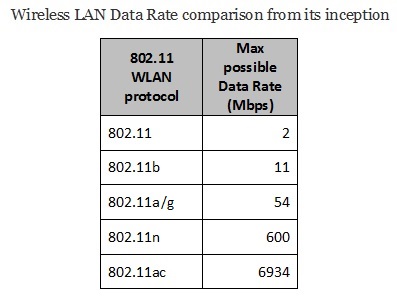Gigabit WiFi or the IEEE 802.11ac is the newest Wireless LAN standard in the market which is promising speeds close to 7 Gbps. This is a huge leap in technology, considering the humble beginnings of Wireless LAN. WLAN or more commonly the WiFi network, has a long and interesting history behind its evolution. The original Wireless LAN standard, the IEEE 802.11, was initially developed in 1997 in 2.4GHz ISM (Industrial, Scientific and Medical) radio spectrum. It had throughput of 1 or 2 Mbps, which was not fast enough for the growing computing needs.
Later in 1999, 802.11b standard was introduced that supported speeds upto 11 Mbps. Though this was a great improvement from previous standard, the devices encountered a lot of interference from many domestic appliances working in the same spectrum, like microwave ovens etc.

While 802.11b was being developed, the 802.11a standard was also developed when 5 GHz spectrum was opened from the UNII band (Unlicensed National Information Infrastructure) in 1997. This standard provided enhanced data rates upto 54 Mbps. But as is the deal with increasing frequency, these devices had lesser range and had trouble penetrating walls.
In early 2000, the 802.11g standard was introduced and it tried to combine the best of both words of 11a and 11b. This supported 54 Mbps speed in the 2.4 Ghz spectrum, which automatically resulted in increased range.
In 2009, 802.11n was introduced and it supported speeds upto 450 Mbps by using smart antenna technologies like SU-MIMO (Single User-Multi Input Multi Output) that uses multiple spatial streams ( Maximum of 4) at transmitting and receiving ends. 11n standard operated in both 2.4 Ghz and 5 Ghz spectrum.
The latest standard of 802.11ac was finalized in 2013. This is called the Gigabit WiFi as it will support theoretical speeds upto 3500 Mbps or 3.5 Gbps over the 5 Ghz band. The technology can technically support upto 8 spatial streams.

The current advantage of 802.11ac is that the 5Ghz band is relatively congestion free. Also 11ac supports a smart wireless concept called “beam-forming”, which focuses signals in the direction of the connecting devices. This helps in providing better signal strength to connecting devices than previous technologies. 11ac also has more channel width of 80 Mz and going upto 160 Mz when compared to 11n standard of 20 Mz and 40 Mz.,
The next iteration of 802.11ac is the Wave-2 standard, which can transmit speeds close to 7 Gbps, using MU-MIMO (Multi-user MIMO).

As can be seen from the image above, the MU-MIMO technology is expected to give excellent end user experience, as each device will virtually be having its own access point, instead of practically sharing from a common pool of wireless signals radiated from APs in SU-MIMO.
From early 2015, Wave-2 devices have started hitting the market. But there is a big debate going on as to whether customers need to upgrade to Wave-2 devices or wait out until 2019 when the next gen devices built on 802.11ax could be entering the market, after IEEE ratification around 2018. The 802.11ax devices are expected to have a throughput of 10 Gbps or more. But more than throughputs, 11ax is expected to address the congestion issue in a better way through technologies like MIMO-OFDM.
As can be seen, gigantic improvements have been made in WLAN specifications to help us reach the current status of 802.11ac Gigabit Wifi. The future only looks more exciting with better improvements waiting in the horizon.
